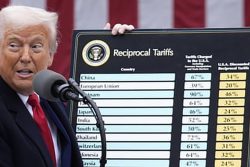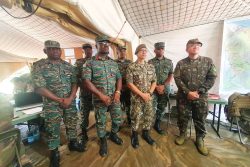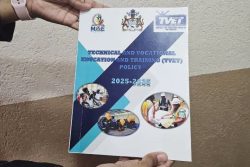The management of drainage and irrigation has always been central to existence on the coastland. Guyana Review reprints this essay that was first published in the book “Building Confidence: The Story of British Guiana in 1954.”
During his tenure of office as Consulting Engineer to the Government of British Guiana, Mr F H Hutchinson made preliminary plans for harnessing certain of the Colony’s rivers with a view to establishing a comprehensive system of water control which would prevent flood and drought in British Guiana. These schemes were as follows:

Mr Hutchison’s approach to the problem in British Guiana was based on his extensive experience in India and he stated that the traditional method of empoldering small ‘islands’ of land in the coastal belt could not be continued. This system, while securing the safety of the empoldered area, only accentuated the problem outside that area and, if developed, would ultimately result in a situation where the protection of land would become progressively more expensive and would deny large areas to cultivation because of the practical impossibility of securing them against flood damage.
Approach
He therefore decided to tackle the problem at its source and endeavour to impound the flood water by constructing conservancies in the upper reaches of the rivers and regulating the discharge to avoid flooding in the coastal plain. The added advantage of this system was that potential irrigation water would also be stored for controlled use during dry weather spells. Of the schemes he put forward, the Boerasirie Project now being constructed was the one which Government decided to put in hand as the first completely integrated scheme.
Mr Hutchinson considered the protection of the whole coastal area and, in the comparatively short time he was studying this problem, he could not produce schemes ready to be put in hand and constructed straight away. This point was emphasized in most of his reports which state quite definitely the need for further detailed study.
Mr Hutchinson’s project schemes were based on what are described as Part I surveys and were not closely controlled, accurate surveys needed for constriction purposes. This is the normal way in which engineering work is evaluated in its preliminary stages. It is obviously impossible in undeveloped countries to spend large sums of money on close surveying of land when it is merely examination to see if a project is feasible. When a preliminary evaluation has been made and proves to be favourable, then the surveyors carry out closely controlled surveys. Of course, in a country with accurate maps the problem is very much simplified.
Schemes
In none of Mr Hutchinson’s schemes has Part II Surveys yet been done. Even on Boerasirie, in order to get work moving, the contract was let without doing these surveys in full and the Department has had to put a very large part of its surveying strength on to this project in order to get the information for the detailed designing, and not hold up the contractors.
In the Boerasirie Scheme, with the exception of the Main Crown Dam, all the detail and design work for the drainage trenches, canals, sluices and similar structures was completed in the Drainage and Irrigation Office after Mr Hutchinson left the Colony.
The Tapakuma Scheme has not been fully surveyed and the very great depth of pegasse on which heavy construction works such as dams would have to be based and which is known to exist on a large part of the area would appear to present serious technical difficulties.
The Mahaica Project has not been fully surveyed and, in fact, from the information that Mr Hutchinson had before he left, he himself was doubtful as to whether the scheme could be implemented as at first contemplated due to the extreme depth of pegasse on the banks of the upper reaches of the Mahaica River. Very detailed surveys of this area are needed before any decision can be taken on this scheme.
The Mahaicony-Berbice Project has not been fully surveyed even in its Part I stages. On the Canje Project no Part II Surveys have been undertaken except the surveys of the 27, 000 acres of Blocks I and II which are almost completed, and this area would ultimately form part of the Canje Project.
In addition to the engineering work contemplated on these schemes, the method of control of irrigation water etc., contemplated by Mr Hutchinson would envisage very drastic revision of British Guiana’s system of land tenure, the Drainage and Irrigation Ordinance and attendant legislation.
The cost figures quoted by Mr. Hutchinson − which are very large sums by British Guiana’s standards and which would certainly be increased, having regard to the time when they were made − did not include items such as roads, water supply and other public utilities, schools and social services, sea defences and land settlement generally.
Block III and Blocks I and II Corentyne, with the attendant Torani Canal, were schemes designed to give some immediate relief to the need for additional cultivable land in the Corentyne as it was undesirable for the Colony to mark time and do no drainage and irrigation work until the major Canje Project could be completed. The Government policy is that the Boerasirie Project and Blocks I and II should go on together and this is the present programme.
Long-range planning
The technical opinion of outside authorities, i.e., the World Bank Mission and Mr Gerald Lacey, CIE, MICE, Adviser to the Secretary of State for the Colonies on Drainage and Irrigation, is agreed in saying that this Colony cannot attempt more than two schemes at the same time and they have emphasized that engineering studies and careful long-range engineering planning are required years in advance of work on any major project. The World Bank Report stated that, “in order to build in 1958, it is necessary to begin planning in 1954” and that “to reclaim additional coastlands requires careful long-range planning years in advance of work on any major project.”
Mr Hutchinson’s schemes indicate the lines along which development in the control of drainage and irrigation should take place. It is very necessary now that some long-range investigation and engineering studies should be undertaken to examine his suggestions and see whether they can be implemented and, if so, at what cost.
In order that this long-range planning should be done, Mr. Lacey recommended that a separate Drainage and Irrigation Department be established with a staff adequate to perform its functions. The first steps in forming this Department were taken during the year under review but the question of staffing remains a very serious problem and, until adequate engineering staff is obtained, very little can be done.
There is, unfortunately, a world shortage of engineers and their services are extremely difficult to obtain. Mr Lacey sums up the difficulties facing British Guiana in paragraph 80 of his report, where he states: “It is clear that it will be quite impossible to implement these recommendations, or to carry out the major drainage and irrigation projects now contemplated, unless an adequate staff of experienced engineers and surveyors can be recruited.”
“The International Bank Mission have endorsed the principle of Mr Hutchinson, the late Consulting Engineer, that development should not depend on further empoldering but should be based on a system of storage works constructed in the upper part of river catchments.
The technical soundness of the Boerasirie Project has been fully established and the remaining Hutchinson projects, all in varying stages of completeness, form a valuable blueprint for further progress which, however, must not be slavishly followed. A vast amount of work remains to be done in the way of hydrological, topographical and soil surveys. Detailed designs have yet to be prepared and further investigation may make radical modifications necessary.
It would be a great mistake to conclude that, if the money and contractors were forthcoming, these projects could be executed forthwith.”










